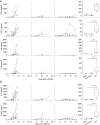Early control of viral load by favipiravir promotes survival to Ebola virus challenge and prevents cytokine storm in non-human primates
- PMID: 33780452
- PMCID: PMC8031739
- DOI: 10.1371/journal.pntd.0009300
Early control of viral load by favipiravir promotes survival to Ebola virus challenge and prevents cytokine storm in non-human primates
Abstract
Ebola virus has been responsible for two major epidemics over the last several years and there has been a strong effort to find potential treatments that can improve the disease outcome. Antiviral favipiravir was thus tested on non-human primates infected with Ebola virus. Half of the treated animals survived the Ebola virus challenge, whereas the infection was fully lethal for the untreated ones. Moreover, the treated animals that did not survive died later than the controls. We evaluated the hematological, virological, biochemical, and immunological parameters of the animals and performed proteomic analysis at various timepoints of the disease. The viral load strongly correlated with dysregulation of the biological functions involved in pathogenesis, notably the inflammatory response, hemostatic functions, and response to stress. Thus, the management of viral replication in Ebola virus disease is of crucial importance in preventing the immunopathogenic disorders and septic-like shock syndrome generally observed in Ebola virus-infected patients.
Conflict of interest statement
The authors have declared that no competing interests exist.
Figures






Similar articles
-
Antiviral efficacy of favipiravir against Ebola virus: A translational study in cynomolgus macaques.PLoS Med. 2018 Mar 27;15(3):e1002535. doi: 10.1371/journal.pmed.1002535. eCollection 2018 Mar. PLoS Med. 2018. PMID: 29584730 Free PMC article.
-
Efficacy of favipiravir (T-705) in nonhuman primates infected with Ebola virus or Marburg virus.Antiviral Res. 2018 Mar;151:97-104. doi: 10.1016/j.antiviral.2017.12.021. Epub 2017 Dec 28. Antiviral Res. 2018. PMID: 29289666
-
Ribavirin does not potentiate favipiravir antiviral activity against Ebola virus in non-human primates.Antiviral Res. 2020 May;177:104758. doi: 10.1016/j.antiviral.2020.104758. Epub 2020 Mar 2. Antiviral Res. 2020. PMID: 32135218
-
Addressing Therapeutic Options for Ebola Virus Infection in Current and Future Outbreaks.Antimicrob Agents Chemother. 2015 Oct;59(10):5892-902. doi: 10.1128/AAC.01105-15. Epub 2015 Jul 27. Antimicrob Agents Chemother. 2015. PMID: 26248374 Free PMC article. Review.
-
Modeling Favipiravir Antiviral Efficacy Against Emerging Viruses: From Animal Studies to Clinical Trials.CPT Pharmacometrics Syst Pharmacol. 2020 May;9(5):258-271. doi: 10.1002/psp4.12510. Epub 2020 Apr 28. CPT Pharmacometrics Syst Pharmacol. 2020. PMID: 32198838 Free PMC article. Review.
Cited by
-
Pathogenesis, Diagnosis, and Management of Cytokine Release Syndrome in Patients with Cancer: Focus on Infectious Disease Considerations.Curr Oncol. 2025 Mar 28;32(4):198. doi: 10.3390/curroncol32040198. Curr Oncol. 2025. PMID: 40277755 Free PMC article. Review.
-
Comparison of Routes of Administration, Frequency, and Duration of Favipiravir Treatment in Mouse and Guinea Pig Models of Ebola Virus Disease.Viruses. 2024 Jul 9;16(7):1101. doi: 10.3390/v16071101. Viruses. 2024. PMID: 39066263 Free PMC article.
-
Single-Shot ChAd3-MARV Vaccine in Modified Formulation Buffer Shows 100% Protection of NHPs.Vaccines (Basel). 2022 Nov 15;10(11):1935. doi: 10.3390/vaccines10111935. Vaccines (Basel). 2022. PMID: 36423030 Free PMC article.
-
Ophthalmological manifestations and plasma markers of inflammation in Ebola survivors in post-treatment era.Sci Rep. 2025 Apr 29;15(1):14966. doi: 10.1038/s41598-025-96256-4. Sci Rep. 2025. PMID: 40301432 Free PMC article.
-
Single Dose of a VSV-Based Vaccine Rapidly Protects Macaques From Marburg Virus Disease.Front Immunol. 2021 Oct 27;12:774026. doi: 10.3389/fimmu.2021.774026. eCollection 2021. Front Immunol. 2021. PMID: 34777392 Free PMC article.
References
-
- Sissoko D, Laouenan C, Folkesson E, M’Lebing A-B, Beavogui A-H, Baize S, et al.. Experimental Treatment with Favipiravir for Ebola Virus Disease (the JIKI Trial): A Historically Controlled, Single-Arm Proof-of-Concept Trial in Guinea. Lipsitch M, editor. PLOS Med [Internet]. 2016. March 1 [cited 2020 Jan 28];13(3):e1001967. Available from: https://dx.plos.org/10.1371/journal.pmed.1001967 - DOI - PMC - PubMed
-
- Bixler SL, Bocan TM, Wells J, Wetzel KS, Van Tongeren SA, Dong L, et al.. Efficacy of favipiravir (T-705) in nonhuman primates infected with Ebola virus or Marburg virus. Antiviral Res [Internet]. 2018. March;151:97–104. Available from: https://linkinghub.elsevier.com/retrieve/pii/S0166354217307374 10.1016/j.antiviral.2017.12.021 - DOI - PubMed
-
- Guedj J, Piorkowski G, Jacquot F, Madelain V, Nguyen THT, Rodallec A, et al.. Antiviral efficacy of favipiravir against Ebola virus: A translational study in cynomolgus macaques. Boyles T, editor. PLOS Med [Internet]. 2018. March 27;15(3):e1002535. Available from: 10.1371/journal.pmed.1002535 - DOI - PMC - PubMed
MeSH terms
Substances
LinkOut - more resources
Full Text Sources
Other Literature Sources
Medical

